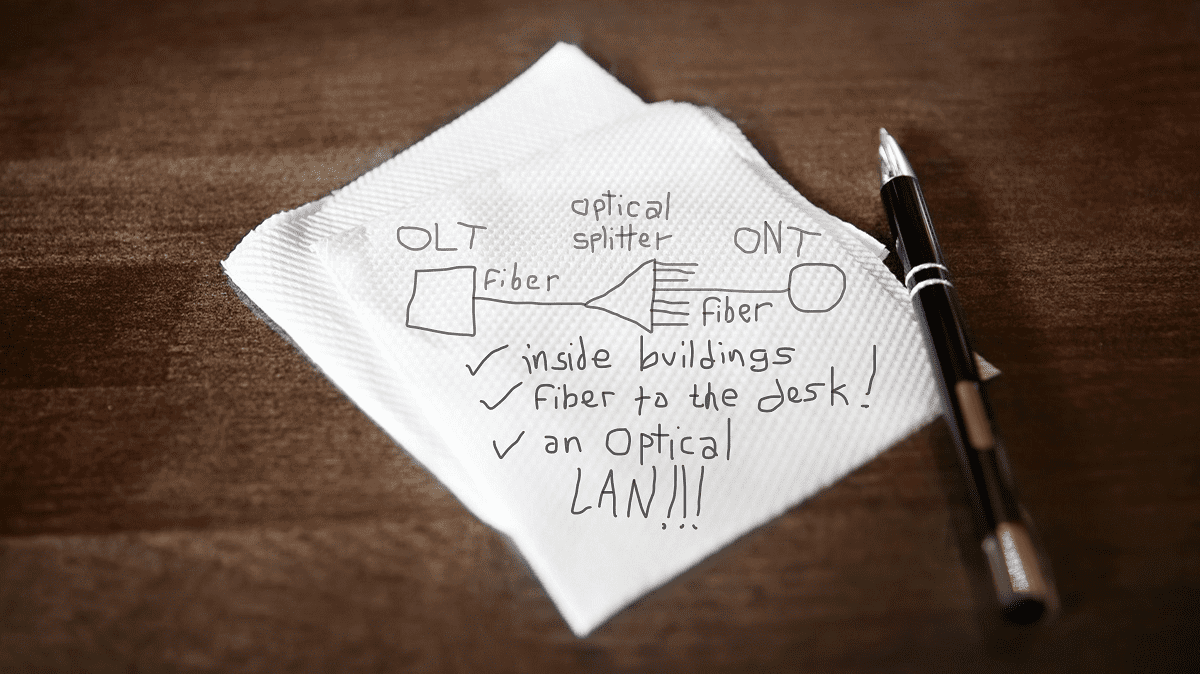Find out where the concept of Optical LAN began. Read the history of how Optical LAN originated from a back of napkin sketch to a growing global technology.
With all the successful deployments of Optical LAN over the last decade across multiple enterprise market verticals, have you ever wondered where it all started? I recall the very meeting, at least from my perspective.
The initial concept of Passive Optical Networking (PON) technology in a Local Area Network (LAN) application can be traced back to discussions over 15 years ago with Verizon Federal Network Systems (FNS). At that time, FNS was a part of Verizon and focused on supporting the unique requirements of the U.S. Intelligence Community (Verizon FiOS tech heading to enterprises, May 2008).
The FNS engineering director and I met for lunch. We discussed his idea of leveraging Tellabs PON solution, that was already widely deployed by Verizon’s successful FiOS Fiber-to-the-Home, for a LAN application to solve challenges faced by his national security customers inside buildings and across extended campuses. On a napkin, he drew a building, and, in each telecommunications room, he drew a PON splitter. During this time, splitters were mainly used outdoors on telephone poles, to serve multiple homes in a neighborhood. In his drawing, this splitter would replace Ethernet switches and create space in telecommunications rooms. He then showed the concept of using Optical Network Terminals (ONT), typically found outdoors on the side of homes, and placing them on each employee’s desktop.
The ability to extend fiber connections to individual desktops would provide a significant cost reduction in equipment and cabling for customers. It would eliminate power requirements in telecommunications rooms. Further discussing the application, we realized that the nature of PON would bring tremendous efficiency to the LAN operator in terms of IT staff operations and network security.
Excited by the idea, I returned to Tellabs engineering division to discuss and brainstorm. Tellabs’ engineer saw the vision of how PON in a LAN application would be a game changer. The effort would require a big investment from different departments due to the significant planning, development, and design required. The same engineers, who focused on developing features and new products for the largest global telecommunications companies, would need to refocus time so this new indoor ONT would be a success and open a new market. The engineers immediately began working and researching the development of an indoor ONT.
Despite enthusiasm toward our progress, I soon found myself facing pressure from other groups within the company to abandon the project. Some were skeptical of the new technology and felt that the company should focus on the core base of customers. However, I refused to give up on this vision.
Following our initial enterprise PON deployments, Tellabs was acquired by private equity investors. The unique value and potential of the solution we were providing to the enterprise LAN market were recognized by our new ownership. Ultimately, they decided to spin off our division, focused on PON, as a stand-alone company. Our team elected to keep the Tellabs brand which held a solid reputation and creditability for quality carrier-class products and support. The other solutions in the Tellabs portfolio, at the time of acquisition, were merged into another portfolio company under a different name.
Since then, Tellabs Optical LAN has been deployed by all military services for all classifications, DISA, Intelligence Agencies, Special Operations Community, Dept of Homeland Security, and numerous federal civilian agencies. Optical LAN has been deployed across bases and campuses, inside buildings, and even on ships. Commercial enterprise markets leveraged the early federal deployments and began to deploy Optical LAN widely. Markets included hospitality, transportation, manufacturing, healthcare, corporations, gaming, etc. Industry partners soon joined and created a host of splitters and remote powering solutions to better support the indoor application. Additionally, there are now at least seven other manufacturers now in the Optical LAN market – thus validating customer and market adoption.
Since its origins, the Optical LAN market has witnessed remarkable and consistent growth in global demand. Last year, the Building Services Research & Information Association (BSRIA) worldwide Optical LAN study noted 109% annual growth including expansions into new verticals and into new geographic markets.
While it is astounding to see how far this market has come from its origins, we are just getting started with significant growth ahead of us. Today, in the vast LAN market, new customers are selecting Optical LAN as the better way to build and operate networks every day and I’m happy to be a little part of the history and the future of this technology.
To keep current with Optical LAN’s accelerating growth into all enterprise market verticals, please join our social media community at Facebook, LinkedIn, Twitter, Instagram, and YouTube.
